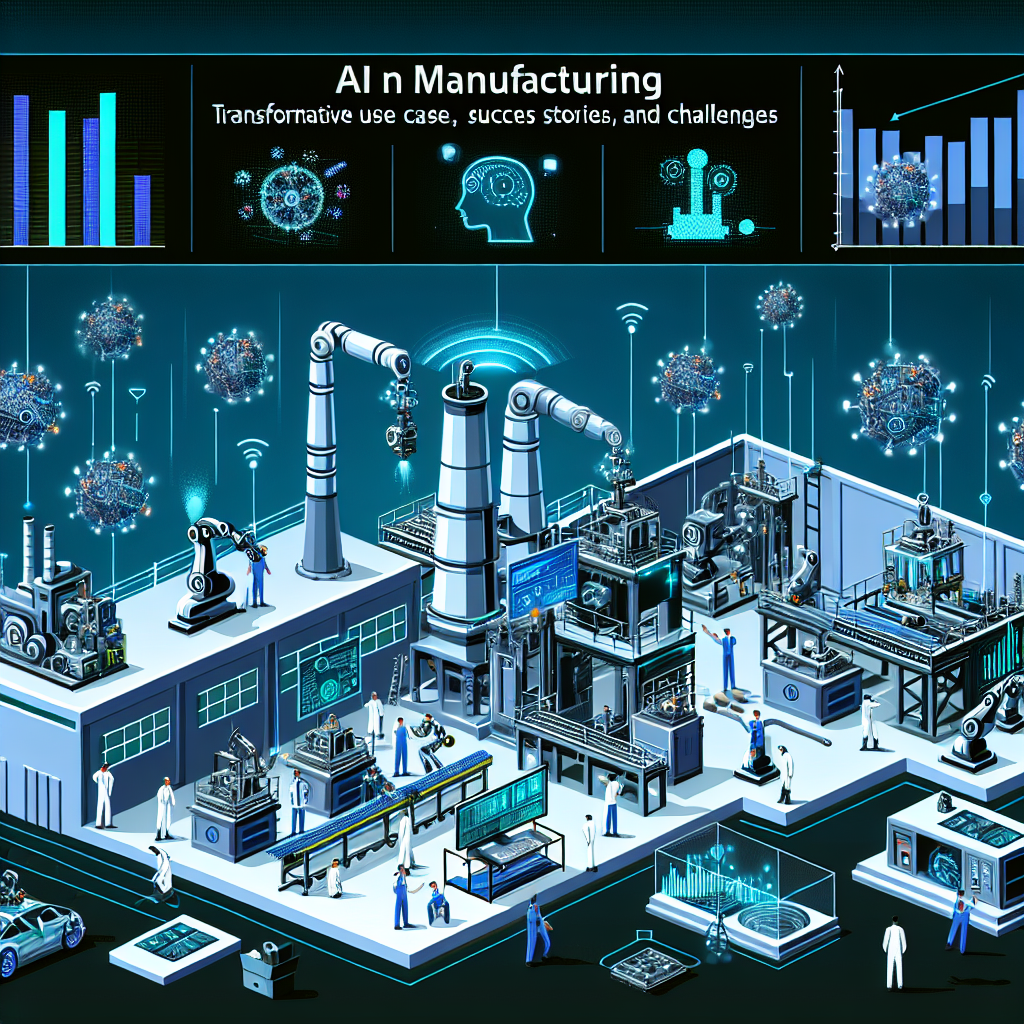AI in Manufacturing: Transformative Use Cases, Success Stories, and Challenges

```html
In the dynamic world of manufacturing, AI is emerging as a critical tool to enhance efficiency, accuracy, and productivity. From predictive maintenance to quality control, AI is redefining how manufacturers operate. In this blog post, we will explore the various use cases of AI in manufacturing, share success stories, and discuss the challenges and lessons learned along the way.
Predictive Maintenance
One of the most impactful applications of AI in manufacturing is predictive maintenance. By leveraging machine learning algorithms, companies can predict equipment failures before they occur, reducing downtime and saving costs. Companies like Siemens and General Electric use AI to monitor machinery, forecast potential breakdowns, and schedule timely maintenance.
Despite its advantages, implementing predictive maintenance can present challenges. A manufacturing plant encountered difficulties when their AI model produced false alarms, leading to unnecessary maintenance actions. This highlighted the importance of fine-tuning AI algorithms to balance sensitivity and specificity and ensuring continuous data validation for accuracy.
Quality Control and Inspection
AI is enhancing quality control processes by automating the inspection of products. Vision systems powered by AI can detect defects and anomalies with high precision, ensuring that only products meeting the highest standards reach customers. Companies like BMW and Foxconn use AI-driven quality control systems to improve product reliability and reduce waste.
However, automating quality control with AI can face obstacles. A manufacturing company discovered that their AI inspection system struggled with variations in product appearance, leading to missed defects. This underscored the importance of training AI models with diverse datasets and incorporating feedback loops to continuously improve accuracy.
Supply Chain Optimization
AI is optimizing supply chains by predicting demand, managing inventory, and optimizing logistics. Companies like DHL and UPS use AI to streamline supply chain operations, reducing costs and improving efficiency. AI algorithms analyze market trends, historical data, and other factors to ensure a seamless supply chain.
Despite its benefits, AI-driven supply chain optimization can encounter challenges. A manufacturer faced inventory shortages when their demand forecasting model failed to account for unexpected market shifts. This highlighted the need for integrating real-time data and adaptive algorithms to handle dynamic supply chain conditions effectively.
Robotics and Automation
AI-powered robotics are transforming manufacturing by automating repetitive and complex tasks. Collaborative robots, or "cobots," work alongside human operators to enhance productivity and safety. Companies like FANUC and KUKA deploy AI-driven robots to perform tasks such as assembly, welding, and material handling with high precision.
However, the adoption of robotics and automation can face hurdles. A manufacturer experienced productivity loss when their robotic system malfunctioned due to software errors. This emphasized the importance of regular maintenance, thorough testing, and having contingency plans in place to ensure uninterrupted operations.
Energy Management
AI is helping manufacturers optimize energy consumption by analyzing energy usage patterns and identifying opportunities for savings. Companies like Schneider Electric and Siemens use AI to monitor energy consumption in real-time, reducing costs and promoting sustainability. AI-driven energy management systems can predict peak usage periods and optimize energy distribution accordingly.
Nevertheless, deploying AI for energy management can present challenges. A plant encountered difficulties when their AI system failed to account for seasonal variations, leading to inaccurate energy predictions. This highlighted the need for robust data integration and continuous model refinement to ensure reliable energy management.
Product Design and Development
AI is accelerating product design and development processes by offering insights and optimizing designs. Companies like Autodesk and Dassault Systèmes use generative design algorithms to create innovative prototypes based on specified criteria. AI enables faster iterations, reducing the time and cost associated with product development.
However, integrating AI into product design can face hurdles. A design team encountered issues when their AI-generated prototypes did not align with manufacturing capabilities, highlighting the importance of ensuring AI models are compatible with practical constraints and involving human expertise in the final decision-making process.
The Future of AI in Manufacturing
The future of AI in manufacturing holds tremendous potential with advancements in real-time process optimization, AI-driven supply chain resilience, and autonomous factory operations. AI's capabilities in data analysis, automation, and predictive insights will continue to drive significant innovations that shape the future of manufacturing.
To fully leverage AI's potential in manufacturing, addressing ethical considerations, ensuring data privacy, and fostering collaboration between technologists and manufacturing professionals are crucial. A balanced approach that combines AI technology with human expertise will be key to navigating the complexities and opportunities AI brings to the manufacturing sector.
In conclusion, AI is revolutionizing manufacturing through predictive maintenance, quality control, supply chain optimization, robotics and automation, energy management, and product design. Success stories from industry leaders like Siemens and BMW demonstrate AI's transformative impact, while challenges emphasize the need for continuous refinement and ethical practices. As AI technology advances, its role in manufacturing will expand, offering new opportunities for innovation, efficiency, and enhanced productivity.
```



